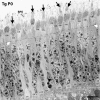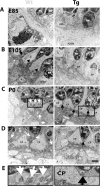A Pro23His mutation alters prenatal rod photoreceptor morphology in a transgenic swine model of retinitis pigmentosa
- PMID: 24618321
- PMCID: PMC4004442
- DOI: 10.1167/iovs.13-13723
A Pro23His mutation alters prenatal rod photoreceptor morphology in a transgenic swine model of retinitis pigmentosa
Abstract
Purpose: Functional studies have detected deficits in retinal signaling in asymptomatic children from families with inherited autosomal dominant retinitis pigmentosa (RP). Whether retinal abnormalities are present earlier during gestation or shortly after birth in a subset of children with autosomal dominant RP is unknown and no appropriate animal RP model possessing visual function at birth has been available to examine this possibility. In a recently developed transgenic P23H (TgP23H) rhodopsin swine model of RP, we tracked changes in pre- and early postnatal retinal morphology, as well as early postnatal retinal function.
Methods: Domestic swine inseminated with semen from a TgP23H miniswine founder produced TgP23H hybrid and wild type (Wt) littermates. Outer retinal morphology was assessed at light and electron microscopic levels between embryonic (E) and postnatal (P) day E85 to P3. Retinal function was evaluated using the full field electroretinogram at P3.
Results: Embryonic TgP23H rod photoreceptors are malformed and their rhodopsin expression pattern is abnormal. Consistent with morphological abnormalities, rod-driven function is absent at P3. In contrast, TgP23H and Wt cone photoreceptor morphology (E85-P3) and cone-driven retinal function (P3) are similar.
Conclusions: Prenatal expression of mutant rhodopsin alters the normal morphological and functional development of rod photoreceptors in TgP23H swine embryos. Despite this significant change, cone photoreceptors are unaffected. Human infants with similarly aggressive RP might never have rod vision, although cone vision would be unaffected. Such aggressive forms of RP in preverbal children would require early intervention to delay or prevent functional blindness.
Keywords: electron microscopy; electroretinography; photoreceptor morphology; retinitis pigmentosa; swine.
Figures






References
-
- Milam AH, Li Z-Y, Fariss RN. Histopathology of the human retina in retinitis pigmentosa. Prog Ret Eye Res. 1998; 17: 175–205 - PubMed
-
- Haim M. Prevalence of retinitis pigmentosa and allied disorders in Denmark. Acta Ophthalmol. 1992; 70: 615–624 - PubMed
-
- Weleber RG. Retinitis Pigmentosa and Allied Disorders. 2nd ed. St. Louis: Mosby; 1994: 335–466
-
- Berson EL, Gouras P, Gunkel RD. Rod response in retinitis pigmentosa, dominantly inherited. Arch Ophthalmol. 1968; 80: 58–67 - PubMed
-
- Berson EL, Simonoff EA. Dominant retinitis pigmentosa with reduced penetrance. Further studies with the electroretinogram. Arch Ophthalmol. 1979; 97: 1286–1291 - PubMed
Publication types
MeSH terms
Substances
Grants and funding
LinkOut - more resources
Full Text Sources
Other Literature Sources

